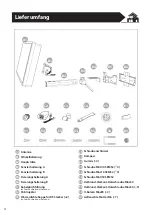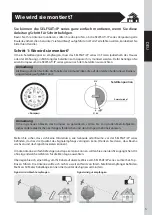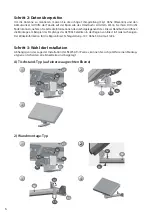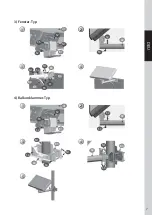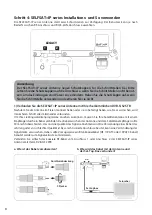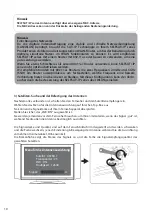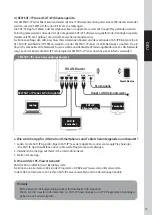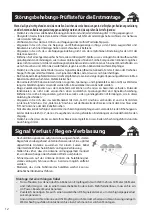
12
Installation Using Long Cable
For installations where the RG 6 cable runs from the receiver(s) to the LNB far exceeds 100 feet
(150 feet or more), as encountered in a commercial or multi-dwelling building, you need to use
an AC power booster module to bias the LNB.
You will also need an additional RF signal amplifier to compensate the signal amplitude loss.
Otherwise, your antenna and receiver may not work properly and be subject to frequent
outages in adverse weather. Contact a professional concerning such installations.
Make sure all cable connections are correct and each connection is seated / tightened properly.
Inspect the inside of each cable connector for dirt or possible connector to case/shield short.
Verify the Azimuth, Elevation and Tilt angles for your location by ZIP code.
Make sure the Tilt and Elevation pointers are aligned correctly to the scales. Do not use washer or bolt as
reference.
Make sure the Tilt adjustment is not changed from the recommended setting for the antenna location.
Remove exiting TV-specific components, such as TV splitter, etc; reduce the installation to the basic
connections called out in this guide. Such components may not work with the satellite signal and they
may be in the wall where you can’t see them. When in doubt, run RG 6 cable directly to your receiver.
Make sure there are no obstructions (trees, buildings, windows, corner or overhang of your roof, your
body or hands) – the signal does not leaves, branches, glass, etc.
RG 6 cable with solid copper center conductor is highly recommended because it has much lower DC
voltage drop compared to RG 6 cable with a copper-coated, steel center conductor.
Standard RG 59 cable causes too much DC drop and signal drop; it can not be used to pass the satellite
signal. RG 6 coaxial cable must be used.
Some after-market, off-the-shelf add-on components may not be as advertised. They might not work or
could cause additional DC drops and signal amplitude attenuation. Remove such components, go back
to the basic connections called out in this manual and re-verify.
Make sure the satellite cable is connected to the “Sat In” jack, not the “Antenna In” jack. The “Antenna In”
jack at the back of the receiver is for off-air antenna input or cable TV input.
If all are done correctly but the signal is still not found, change the Elevation adjustment of the antenna
slightly (±2°C, the ±4°C from the called-for setting) and repeat the procedure.
Make sure the Access Card from your receiver is fully inserted into the Access Card slot and oriented
correctly.
•
•
•
•
•
•
•
•
•
•
•
•
•
The satellite signal may lost temporarily due to unusually heavy
rainfall. An optimally aligned antenna, along with the shortest
possible cable run, minimizes the chances of “rain fade.”
Make sure the antenna is mounted securely to prevent it from
being blown out of alignment in a heavy wind.
Heavy snow accumulation on the antenna may reduce the
satellite signal strength; snow should be swept away as soon as
possible.
Tree foliage growth into antenna’s line-of-sight to the satellite
may result in gradual loss of picture.
•
•
•
•
If the signal is not found, be sure the receiver user manual and the antenna user
manual have been followed closely, check the following:
Signal Loss / Rain Fade
Troubleshooting Check List for Initial Installation
•
•

















